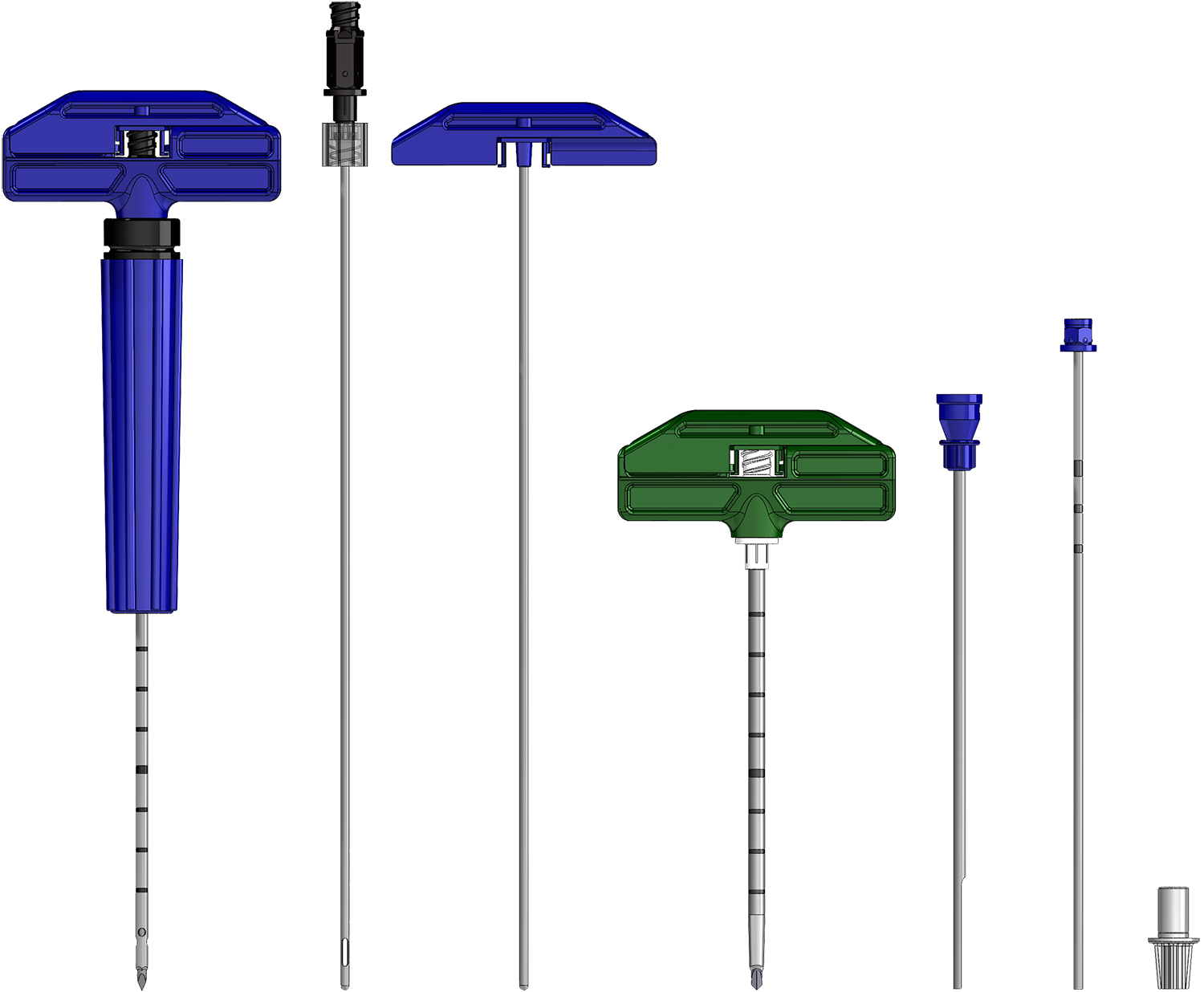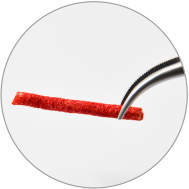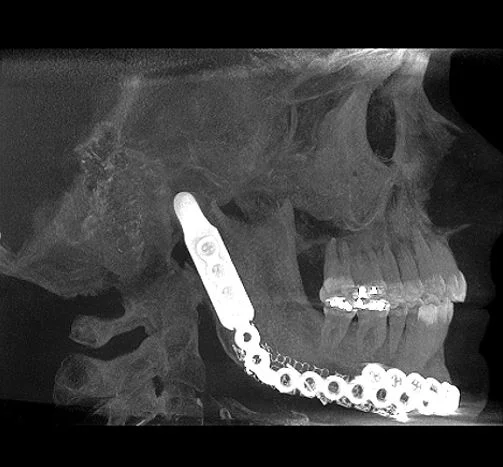


Marrow Cellution™
Aspirate to Application®
The patent pending MARROW CELLUTION™ Bone Marrow Harvesting Systems overcome the limitations of a traditional bone marrow needle and results in a bone marrow harvest that is so rich in key stem and progenitor cells that the aspirate may no longer require manipulation through centrifugation prior to application.
Marrow Cellution™
Aspirate to Application®
The patent pending MARROW CELLUTION™ Bone Marrow Harvesting Systems overcome the limitations of a traditional bone marrow needle and results in a bone marrow harvest that is so rich in key stem and progenitor cells that the aspirate may no longer require manipulation through centrifugation prior to application.

Marrow Cellution™ Overview
Marrow Cellution™ Overview
How It Works:
Traditional Needles...
... produce excess peripheral blood contamination, diminishing cellular yield; thereby requiring additional manipulation steps to achieve the cellular demand necessary for most clinical indications.
MARROW CELLUTION™...
...uses its patent(s) pending technology to harvest high quality stem and progenitor cells from various levels within the marrow space, while limiting peripheral blood contamination.
MARROW CELLUTION™ Animation
How does MARROW CELLUTION™compare versus the centrifugation protocol? View Our Scientific Resources
Marrow Cellution™ Bone Grafting
The high cellular composition of Marrow Cellution™ Aspirate combined with percutaneously harvested bone dowel(s) deliver autograft without the associated morbidity.
Marrow Cellution™ Bone Grafting
The high cellular composition of Marrow Cellution™ Aspirate combined with percutaneously harvested bone dowel(s) deliver autograft without the associated morbidity.
Bone Dowel Extraction Steps:
Produces Graft Material with Osteoconductive, Osteoinductive & Osteogenic Properties.
Minimally INVASIVE Technique, Using 8 Gauge Trephine Needle for Bone Dowel Extraction.
May be combined with allogenic, autologous or synthetic bone chips hydrated with marrow aspirate.
MC-RAN-8C Components (from left): Marrow Cellution Introducer Needle, Aspiration Cannula, Blunt Stylet, 8 Gauge Trephine Needle, Extraction Tool, Measurement Probe, Tip Guard
Intact Bone Dowels vs. Morselized Bone
Intact Cancellous Bone Dowel
Harvesting an intact cancelleous bone dowel which does not disrupt the highly-organized living tissue of the bone is different from transplanting pieces of bone. Such grafts that maintain the micro-vascular within the graft do not show extensive resorption, callus formation or remodeling. (1,2) The inherent difference is based on the ability of intact bone to exploit the biology of normal fracture healing rather than through creeping substitution that is fundamental to the incorporation of a non-vascularized graft. (1) Research demonstrates the enhanced survival of a free bone graft as long as its primary blood supply is preserved or re-constituted. A living bone graft will shorten the time for boney union because the reconstructed bone is comparable to a bone with a double fracture. (1,2) Allogenic or synthetic bone chips hydrated with marrow can be packed around the living bone graft/dowel to accelerate anastomosis into the graft and minimize the amount of morbidity. (1,2)
Minimally Invasive Combination Bone Grafts
Vascularized and cancellous autograft show optimal skeletal incorporation but are limited by morbidity concerns. (3) Using the Marrow Cellution™ graft delivery syringe and the Marrow Cellution™ Bone Dowel Harvest device, the clinician can create a combination graft of a vascularized intact bone dowel in the center of the graft surrounded by allogeneic, autologous or synthetic bone chips hydrated with high cellular marrow aspirate. Higher quality, less quantity, delivered appropriately minimizes host morbidity.
Sources:
1) Bleuming SA, He XC, Kodach LL, Hardwick JC, Koopman FA, Ten Kate FJ, van Deventer SJ, Hommes DW, Peppelenbosch MP, Offerhaus GJ, Li L, van den Brink GR (Sep 2007). "Bone morphogenetic protein signaling suppresses tumorigenesis at gastric epithelial transition zones in mice". Cancer Research. 67 (17): 8149–55.
2) Ostrup et al Distant transfer of a free, living bone graft by micro-vascular anastomoses. An experimental study. Plast Reconstr. Surg. 1974 Sep; 54(3): 274-85
3) Taylor G The Free Vascularized Bone Graft: A Clinical Extension of Microvascular Techniques Plastic & Reconstructive Surgery May 1975 volume 55 Issue 5 ppg 533-544
Marrow Cellution™ Bone Graft Procedure
With One Year Follow Up CT Scan Showing Complete Bone Union
Scientific Resources
CLICK ON THE LINKS BELOW FOR MORE INFORMATION
Scientific Resources
CLICK ON THE LINKS BELOW FOR MORE INFORMATION
Disclaimer: None of the clinicians that have contributed samples or written white papers have or has had ANY financial conflict of interest regarding Marrow CELLution or Ranfac Corp. Furthermore, we do not have any paid physician consultants.
Addressing Misleading & Fraudulent Claims
Head to Head Analysis
These analyses explore sets of bone marrow aspirate samples that were collected during surgery from bilateral iliac crest draws with different BMAC Systems and the Marrow Cellution™ System, each being randomly assigned to one iliac crest.
White Papers & Presentations
Marrow Cellution™ Bone Marrow Aspiration System and Related Concentrations of Stem and Progenitor Cells (Click for updated data set)
An edited podium presentation of Dr. Michael Scarpone, presenting the findings by him and Daniel Kuebler, PhD on using the Marrow Cellution™ device without centrifugation.
Updated Paper, titled "Novel Technology To Increase Concentrations of Stem and Progenitor Cells in Marrow Aspiration". n=27
Download the presentation, which compares the data from using the Marrow Cellution™ to other techniques, including centrifugation.
A Comparison: cfu-f per ml
vs. Centrifuge Based Systems
(Data Acquired From Published Sources)
Product Details
MARROW CELLUTION™ IS AVAILABLE IN TWO STYLES AND MULTIPLE SIZES; ALL UTILIZING THE SAME PATENT PENDING TECHONOLOGY TO OPTIMIZE BONE MARROW ASPIRATION.
Product Details
MARROW CELLUTION™ IS AVAILABLE IN TWO STYLES AND MULTIPLE SIZES; ALL UTILIZING THE SAME PATENT PENDING TECHONOLOGY TO OPTIMIZE BONE MARROW ASPIRATION.
For Bone Marrow Aspirate
Catalog # |
Part # |
Description |
| MC-RAN-13C | 74291-01M | 13 Gauge x 3.5" Introducer Needle13 Gauge Blunt Stylet17 Gauge Aspiration Cannula10 mL Syringe |
| MC-RAN-11C | 74219-06M | 11 Gauge x 3.5" Introducer Needle11 Gauge Blunt Stylet14 Gauge Aspiration Cannula10 mL Syringe |
| MC-RAN-11CSTS(For Obese Patients) | 74219-07M | 11 Gauge x 4.5" Introducer Needle11 Gauge Blunt Stylet14 Gauge Aspiration Cannula10 mL Syringe |
For Bone Marrow Aspirate + Percutaneous cancellous bone harvesting
Catalog # |
Part # |
Description |
| MC-RAN-13A | 74293-01M | Includes all MC-RAN-13C components 8 Gauge x 4" Swaged Tip Introducer NeedleMeasurement ProbeCancellous Bone Dowel Extraction Tool |
| MC-RAN-8C | 74266-01M | Includes all MC-RAN-11C components 8 Gauge x 4" Swaged Tip Introducer NeedleMeasurement ProbeCancellous Bone Dowel Extraction Tool |
| MC-RAN-8CSTS(For Obese Patients) | 74266-04M | Includes all MC-RAN-11CSTS components8 Gauge x 6" Swaged Tip Introducer NeedleMeasurement Probe Cancellous Bone Extraction Tool |
Procedure Resources
Procedure Resources
MC-RAN-11C Animation
Marrow Cellution™
Bone Graft Procedure
For Oral Maxiofacial Surgical Bone Defect with One Year Follow Up CT Scan
FAQs
FAQs
Please click here to view our responses to misleading & fraudulent claims.
Does a small volume aspirate have more CFU-f than a larger draw that is then volume reduced by centrifugation?
| CFU-f per mL | 300 |
| volume | 60 mL |
| Total CFU-f per mL | 18,000 |
| Recovery in the concentrate | 60% |
| Total CFU-f in Concentrate | 10,800 |
| Concentrate Volume | 7 mL |
| CFU-f per mL | 1,543 |
| HSS / Hedge Study | 1,270 |
What are the limitations of traditional needles and what is the optimal technique for minimizaing peripheral blood dilution?
What are the different techniques to aspirate marrow using a traditional needle and what can I expect for cfu-f per mL using such techniques?
- Insert the needle and begin to aspirate from a single location (cfu-f 376 per mL; volume 10 ml : cfu-f 95 per mL ; volume 50 mL)
- Insert the needle further into the bone space and aspirate marrow in different locations as you retract the needle from the marrow space (cfu-f 356 per mL; volume 8 mL : cfu-f 52 per mL; volume 30 mL)
- Aspirate marrow using a standard BD 30mL syringe in different locations as you advance the needle into the marrow space by inserting the blunt stylet to advance the trocar to each new depth from which aspirate is taken (cfu-f 54 per mL; volume 30 mL)
- Aspirate marrow using a vacuum assisted (vac-lok merit medical) 30mL syringe in different locations as you advance the needle into the marrow space by inserting the blunt stylet for each new depth from which aspirate is taken.(cfu-f 205 per mL; volume 30 mL)
What is the importance of cfu-f counts compared to nucleated cell counts?
Do I Need to Filter Spicules From Marrow After Aspiration and are Red Cells a Problem?
Spicules:
Fragments, also known as spicules, are aggregates of bone marrow cells that are pulled from the bony matrix of the marrow space (trabecular) during the aspiration process. They represent what will be seen on the bone marrow biopsy as material that came from what was in between the bony trabecular. Many of these aggregates are smaller than 200 micron filter so, you are not filtering many of them out anyway but you do lose them with a centrifugation protocol. Typical filter is capturing fat and clots. Bone Chunks would not fit through the 22 gauge needle or the side ports of the aspiration needle. These cell aggregates are VERY rich in MSC and HSC. (1,2) 1) Ahmadeigi et al ;The aggregate nature of human mesenchymal stromal cells in native bone marrow. Cytotherapy 2012 Sep;14(8):917-24. 2) Ahmadbeigi et al Isolation, Characterization, and Transplantation of Bone Marrow Derived Cell Components with Hemtopoietic Stem Cell Niche Properties Stem Cells Dev. 2013 Dec 1; 22(23): 3052–3061.RBC Count:
The hematocrit of the product from the needle will be the native hematocrit and will be equal to that of centrifugation protocols but will have a slightly higher number of nucleated red blood cells. Red cells are a natural part of any clot and play a role in the regenerative process; it is not necessary to remove them.- Red cell are nitric oxide sinks ( ref 1)
- Nitric Oxide is a potent stem cell stimulant (ref 2)
- Red Cells release iron
- Iron is used by cells under stress to survive and function (ref 3)
- Stem cells reside deep in the red cell layer including very small embryonic-like cells are discarded during centrifugation . (ref 4, 5, 6)
In Vivo Data:
Lastly, this established science corresponds to published in-vivo clinical experience where marrow of a native hematocrit was used to treat knee cartilage defects. No adverse reactions were noted when a native level of marrow cells was used. (1,2) 1) Gobbi A. Et al “One-Step Cartilage Repair with Bone Marrow Aspirate Concentrated Cells and Collagen Matrix in Full-Thickness Knee Cartilage Lesions; Results at 2-Year Follow-up” Cartilage. 2011 Jul; 2(3): 286–299A. 2) Fortier L. et al. “Concentrated Bone Marrow Aspirate Improves Full-Thickness Cartilage Repair Compared with Microfracture in the Equine Model” J Bone Joint Surg Am. 2010 Aug 18;92(10):1927-37WBC Count:
When an aspirate is performed poorly ( i.e. single stick draw using a vac-syringe, aspirate all from one location) the aspirate is comprised mostly of peripheral blood. The density of the float in the marrow kits is greater than the PRP kits and so the BMAC kit will capture more red cells and granulocytes. In the case of a poor aspirate, the only difference between PRP and BMAC, since they are both being made from peripheral blood, is that the BMAC has higher red cells and granulocytes. With a poor aspirate, the higher nucleated cell counts in the centrifugation protocols is due to higher cells from the peripheral blood and not marrow cells. The published literature looks at the number of CFU-F in the marrow product, whether centrifuged or not, to determine the quality of the biologic because CFU-F is found in marrow but not peripheral blood. Clinical results in these peer reviewed journal articles for different muscular skeletal dis-orders were lined to CFU-F in the graft, not the nucleated cell content.Centrifugation / Concentration:
Many cell aggregates from the marrow aspirate are as dense as a mature red cell. (1,2) This is the reason why centrifugation protocols get such a low percent recovery of mesenchymal stem cells (CFU-F); they are thrown away with the red cells. Quote from ref 3 below: “The isolated cells from both the upper and lower fractions were characteristic of MSC. Although it is commonly believed that MSC are single suspending mononuclear cells and so are enriched in the upper fraction of Ficoll-Paque after density-gradient separation, our data showed that considerable numbers of these cells were accumulated in the lower fraction.” (3) Lastly, whole blood is used for epidural patches; if red cells were inflammatory, they could not be used near such sensitive tissues. 1) Juopperi TA, Schuler W, Yuan X, Collector MI, Dang CV, Sharkis SJ. Isolation of bone marrow-derived stem cells using density-gradient separation. Experimental hematology 2007;35:335-41. 2) Bhartiya D, Shaikh A, Nagvenkar P, et al. Very small embryonic-like stem cells with maximum regenerative potential get discarded during cord blood banking and bone marrow processing for autologous stem cell therapy. Stem cells and development 2012;21:1-6. 3) Bhartiva D et al “Very Small Embryonic-Like Stem Cells with Maximum Regenerative Potential Get Discarded During Cord Blood Banking and Bone Marrow Processing for Autologous Stem Cell Therapy” Stem Cells and Development Volume 221 NO 1 2012Is there a relationship between differing volumes of bone marrow aspirates and their cellular composition?
| Volume of Aspirate | |||
| CFU-f / mL | 1458 (5) | 675 (4) | 254 (6) |
What is the relationship between age and aspiration quality for bone marrow?
What is the importance of CD34 compared to nucleated cell counts?
Does the number of cd34+ cells in marrow decline with age?
What has been reported for the number of cd34+ cells per ml from aspirates stratified by age?
| Average | ||||||
| age | sample no | Volume | MNC X10^6 | MNC / mL | CD34 | CD34 / mL |
| 0-20 | 35 | 92 | 434 | 4,717,391 | 1.05% | 49,532.61 |
| 21-40 | 203 | 100 | 403 | 4,030,000 | 1.04% | 41,912.00 |
| 41-60 | 83 | 100 | 367 | 3,670,000 | 0.94% | 34,498.00 |
| 61-80 | 11 | 100 | 302 | 3,020,000 | 0.93% | 28,086.00 |
Do the number of cfu-f cells in marrow decline with age?
Does the overall health of the patient population have an influence on the number of cd34+ cells?
| Source | TNC / mL | CD 34 mL |
| Scheduled for Cardiac Surgery | 9.8 | 49,000 |
| Allogeneic marrow donor | 17.7 | 125,670 |
| Purchased Marrow for Research | 23.5 | 136,764 |
Do certain lifestyle choices impact the number of cd34+ cells & cfu-f in the marrow?
Do certain medications impact the number of cd34+ cells & cfu-f in the marrow?
Do certain diseases impact the number and/or functionality of cd34+ cells & cfu-f in the marrow?
What is the purpose of centrifugation protocols for marrow?
What is the impact of age on peripheral blood platelets and vasculogenesis?
Can the Marrow Cellution Needle be used to aspirate from bones other than the Iliac Crest?

What is the optimal syringe plunger technique and syringe size to optimize the recovery of marrow during aspiration?
Testimonials
Testimonials
“My patients outcomes have improved greatly and quicker since I started using the Marrow Cellution bone marrow needle.”
“Hands down, the best method is the new Marrow Cellution needle. It’s a game changer. Far easier to use, only one insertion point through the PSIS (rather than multiple entry sites through the ilium), and a MUCH better stem cell yield than the traditional Jamshidi needle approach.”
“For the same patient and procedure, the measured number of progenitor cells per cc in the aspirate alone was comparable to the centrifugation concentrate protocol.”
“I am always suspicious that when we centrifuge bone marrow aspirate we might be throwing away significant aspects of the regenerative potential of biologic.”
Contact
Contact
For more information on the patent pending Marrow Cellution™ systems or if you would like speak with a representative, please fill out the form below.
For European Sales, please contact Aspire Medical Innovations or view Brochure














